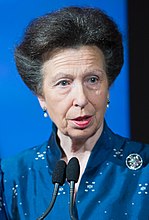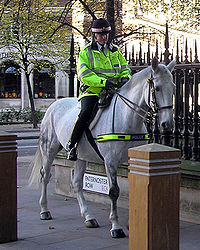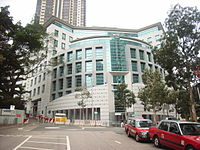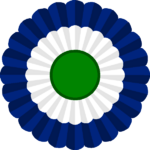Albeinland
This article is incomplete because it is pending further input from participants, or it is a work-in-progress by one author. Please comment on this article's talk page to share your input, comments and questions. Note: To contribute to this article, you may need to seek help from the author(s) of this page. |
Kingdom of Albeinland | |
|---|---|
| Motto: Domine, dirige nos "O Lord, direct us" | |
| Anthem: Albish National Anthem | |
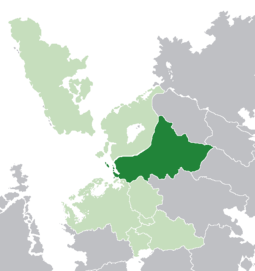 Albeinland (dark green) in the Lorecian Community (light green) in Lorecia (grey) | |
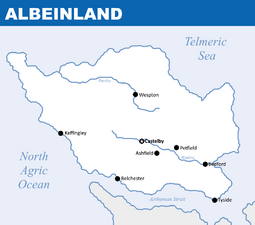 Political map of Albeinland | |
| Capital and largest city | |
| Official languages | English |
| Ethnic groups (2010) | See demographics |
| Demonym(s) |
|
| Government | Unitary parliamentary constitutional monarchy |
• Monarch | Catherine II |
| Vincent Lloyd | |
| Legislature | Royal Assembly |
| Establishment | |
| 08 December 1012 | |
| 23 March 1665 | |
| 05 July 1994 | |
| Area | |
• Total | 1,351,200 km2 (521,700 sq mi) |
| Population | |
• 2020 estimate | 31,394,608 |
• 2011 census | 29,283,129 |
• Density | 23.2/km2 (60.1/sq mi) |
| GDP (nominal) | 2020 estimate |
• Total | $1,311,164,408,512 |
• Per capita | $41,764 |
| Gini (2020) | low |
| HDI (2020) | very high |
| Currency | Albish Sterling (ALB, £) |
| Time zone | Albish Central Time (ACT) |
| Driving side | left |
| Calling code | +32 |
| Internet TLD | .ab |
Albeinland, officially the Kingdom of Albeinland, is a country located on the Astyrian continent of Lorecia, sharing borders with Noordenstaat and Fyngaria to the south, Aswick to the east, Arstotska to the northeast, Western Tundra to the north and the Aurora Confederacy to the northwest. According to its last demographic census, the Albish population is comprised of almost 30 million inhabitants, with the majority of them living on major urban centres.
The first known reports of homo sapiens in the territory that today corresponds to Albeinland comes from Arlethic tribes, an ethnolinguistic group that came from the north and east of Lorecia who established their first villages and settlements in the 4th century BCE. Over the years, external contacts made through trade enabled the expansion of some of these tribes, which formed the first kingdoms. From these kingdoms, three of them managed to establish a hegemony over the other kingdoms and tribes of the region: Anglea, Cambrea and Lencester, with its period being known as the Tritarchy. After years of total control, Gaullic invaders from Haguenau led by the House of Annesley set their own settlements on the coast and, after years of intensive conflict, unified the entire Albish territory into one single kingdom in 1012. The Middle Ages were characterized by the expansion of feudalism and relative stability that served as the base for the beginning of the Albish Renaissance, where it was seen major progress on the fields of arts and science. It was also under this time that most of the population converted to Lutheranism and the monarch obtained absolute powers, becoming chief of the state and the church as well.
However, by the start of the 17th century, bigger confronts against royal power that was worsened by the Albish defeat at the Auroran War led to the start of the Magnanimous Revolution, where the liberal aristocracy and the bourgeoisie (the Oxfords) fought against the more traditionalist nobles that remained loyal to Edmund III (the Cavaliers), resulting in a two-year civil war which ended with an Oxford victory that caused the deposition of Edmund and its dynasty out of power and the establishment of the Royal Charter, making Albeinland one of the first constitutional monarchies in the world. The 18th and 19th centuries are known for being a golden era, with the country staying in the majority of the time under a good economic condition and being at the centre of most philosophic and scientific discussions of Lorecia. In the 20th century, Albeinland testified several social advances such as the introduction of universal suffrage and the creation of a welfare state, although it has been suffered severely, both socially and economically, in the general crisis of 1986.
Currently, Albeinland is a developed country with one of the largest economies of the world. Its political system is operated under a unitary parliamentary constitutional monarchy, with its Monarch Catherine II acting as the chief of state while the Prime Minister Vincent Lloyd acts as the chief of government. The national legislature is the Royal Assembly, which meets commons and peers to discuss and approve new laws. Most part of the Albish population lives in urban zones, with Castelby being its capital and largest city. Albeinland is a founding member of the Lorecian Community and is a member of several other international organizations.
Etymology
The name Albeinland comes from the Old English Albaland, which means “land of the Albans.” Although there isn’t any definitive certainty about the origin of the term, its earliest record comes from Gaullic chronicles dated back in the 5th and 6th centuries, which led many to believe that it is an exonym used by Gaullic merchants at the time to describe Albeinland as a whole that became officialized after the invasion and consequent unification of the region by the House of Annesley. Before the invasion, it’s speculated that the natives called the area as Hwiteland. The reasons that could lead the invaders to use this name could come from the harsh Albish winter, which makes the entire landscape be covered in snow, or the very white skin colour of the natives.
Regarding its gentilic, the current official and most used version by the population is Albish and, although its variations Alban and Albian aren’t considered to be wrong, they are rarely used and seen as archaic.
History
Prehistory and antiquity
Unification and Middle Ages
Renaissance
Magnanimous Revolution
Mordern era
Contemporary era
Geography
Climate
Environment
Politics and government
Albeinland is a unitary parliamentary constitutional monarchy, having as the chief of state the monarch and as the chief of government the prime minister. The government is operated under the Royal Charter of 1665, which established the rights and duties of every governmental institution and laid the foundations for the creation of the current political system, however, although being credited as the Magna Carta, Albeinland has, in fact, a semi-codified constitution, with the Royal Charter being one of the several documents, treaties and conventions that set the obligations of the government, the legislative and the judiciary. As a unitary state, its subdivisions receive limited autonomy that is devolved by the legislature to them, which could be altered or removed at any time under the concept of parliamentary sovereignty.
The monarch is the leader of the country, with its institution being officially created after the unification in 1012. Since 1886, the House of Limsey is the royal house of Albeinland, the seventh dynasty to occupy this position over the centuries. During the Middle Ages, the monarchy had absolute powers either in temporal and religious matters, something that only changed with the Oxford victory in the Magnanimous Revolution. Since then, the monarch has been delegating its powers to the prime minister and its cabinet as well as the Royal Assembly, with the sovereign serving as the referee and moderator of the political system to ensure its operation. The Privy Council acts as an advisory body of the monarch. Furthermore, it was determined that the monarch and other members of the royal family shouldn't interfere or opine on ideological or political subjects for the sake of maintaining a sense of neutrality and staying above them. Although the institution suffered historical rejections in the 80s, today, the monarchy remains extremely popular. Since 1973, the Queen of Albeinland is Catherine II, who succeeded her father Arthur VII.
The Peerage of Albeinland is the legal system of noble titles in the country, titles which are created by the monarch through a letters patent under the consent of the prime minister and the Privy Council, with both of them being able to recommend the nomination of someone to its elevation into the peerage. Currently, there is two types of peers: the hereditary peers, where its title is inherited to its legitimate descendants; and the life peers, who holds the title to their entire life but couldn't be inherited to any of its descendants, with the last one being credited to commons who performed important roles in the government (such as the office of the prime minister) or who contributed to the Albish society as a whole. The aristocracy, as well as the monarchy, still remains extremely influential in the arts, culture, politics and economy of Albeinland in the 21st century.
The prime minister is the chief of government, being generally the leader of the party with the biggest number of seats in the Royal Assembly. It's one of the responsibilities of the prime minister to lead the country on every day matters as well as its institutions and finances through a government plan at the same time that represents the country on the world stage. Although the current nomenclature had been officially adopted by the Duke of Allenburgh in 1886, the office exists since 1665, with its first holder being the Duke of Howerton. Since the post doesn't have a determined term of office, and with the legislation only saying that an election must happen every seven years, it's possible that the incumbent manages to stay in power indeterminately as long as it maintains parliamentary support and confidence. Since 2018, the prime minister of Albeinland is the former economist Vincent Lloyd, from the Conservative Party.
The national legislature of Albeinland is the Royal Assembly, which is formed by 570 Assembly Members (AMs) for a mandate of seven years. Out of these 570 members, 380 of them are elected by the popular vote through a first-past-the-post system, while the remaining 190 AMs are appointed by the monarch under the consent of the prime minister and the leader of the opposition after a general election, with the law saying that they should be peers in charge of representing the State and its interests. As a parliamentary system, it's the job of the assembly to maintain the prime minister and its cabinet accountable, being able to dismiss them through a motion of no-confidence.
The judiciary branch suffered several alterations over the years, with the last major one taking place in 1957. Since then, all national courts were unified, forming the High Court of Justice of Albeinland that acts as both a constitutional court and as a court of last resort to civil and criminal cases. Every province also has its own regional courts.
Albeinland has a complex and ancient system of national subdivisions that is dated from centuries ago. As a unitary state, all subdivisions doesn't present the same autonomy of federal states, with such autonomy being devolved by the Royal Assembly and could be revoked at any time through a parliamentary vote with a simple majority. The first tier of subdivisions is the provinces that currently are Greater Castelby, Anglea, Cambrea, Lencester, Bedfordshire, Cymshire and Saint Laurent. Until 1973, the Channel Islands were a crown dependency, but this status was changed and it officially became a province too. The provinces are led by a Royal Commissary appointed by the monarch after a general election, however, the office is mostly ceremonial, with its only function being to communicate the current situation of the province to the prime minister and warn the government in emergency cases. The only exception to this default rule is from the province of Greater Castelby, which has a Lord Mayor elected democratically. The second and last tier is the shires, which were first created in the Middle Ages and doesn't have an executive but instead a local authority composed of councillors elected every four, five or six years, exerting the function of a local government.
Since the introduction of parliamentarism, Albeinland has a two-party system, with the biggest political parties being the centre-right Conservative Party and the centre-left Social Democratic Party, which are the only ones that managed to elect prime ministers and are alternating power since 1918. Traditionally, the third-largest party is the Liberal Party, while other more recent parties that exert any kind of influence on the political sphere are the Reform Party, the Green Party and the Radicals.
Although being internationally known as one of the oldest democracies in the world, Albeinland has been a target for criticism, especially from journalists and the media, due to the high level of power that the aristocracy still holds on political, economic and social issues, as well as the immense level of traditionalism and conservatism present on the society as a whole. Thanks to this, the country is classified as a flawed democracy.
Military and law enforcement
The Albish Armed Forces are comprised of three branches: the Royal Army, the Royal Navy and the Royal Air Force. Together, they are responsible for the national defence of Albeinland and its borders, being one of the biggest armies within the Lorecian Community which makes the country one of the main military leaders of the bloc. Although the monarch is the commander-in-chief of the armed forces, each branch has its own organization that is aimed to maintain and organize its own forces, being called the General Office, General Air Office and Admiralty Office, which are responsible by the army, air force and the navy, respectively. Each one of these offices is led by a chief or, in the case of the Royal Navy, by the First Lord of the Admiralty. Since 1976, the military enlistment is voluntary and, soon after the end of the Great War, the armed forces started to endorse bigger military integration with neighbouring states.
Regarding civil and military intelligence, the Royal General Intelligence Communications Service, also known as the RGICS, is the national intelligence agency of Albeinland, being created in 1942 and responsible for lead both domestic and foreign, military and civil, Albish intelligence campaigns. In the last years, the RGICS is almost entirely working on anti-terrorism operations and has been a target for criticism for its high level of secrecy in relation to its functioning. The Albish Police Service (APS) is the national law enforcement agency to every province in the country, being managed directly by the government in Castelby. Besides the APS, there is another police force, the Royal Gendarmerie Service, which is treated as riot police specialized in the combat and containment of such.
Foreign relations
Albeinland is considered to be by various international organizations a regional and middle power, being one of the most powerful countries of the Lorecian Community and the one that most exerts influence over other members. Since the 17th century, especially after the Magnanimous Revolution, the country took a more friendly posture with the Empire of Exponent, which allowed the expansion of international trade. However, by the end of the Great War, the Albish government intensified its alliances and relationships with neighbouring countries and started to support more Lorecian integration, with this policy still being in force since then. Today, Albeinland is founder-state of the Lorecian Community as well as a member of the Astyrian Peace Organization and the E10 Council of Nations, among many others.
Economy
Energy
Transport
Agriculture
Tourism
Demographics
Healthcare
Education
Religion
Culture
Music and art
Media
Cuisine
Sports
Holidays
See also


